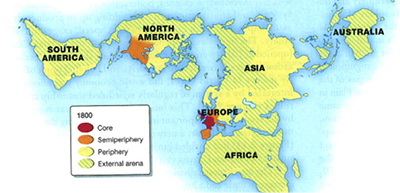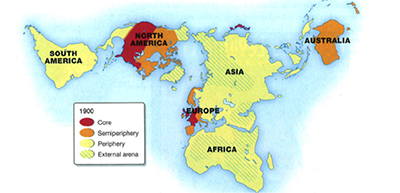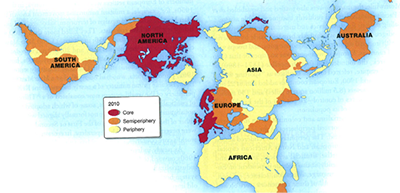One of the economic (geographic) characteristics of contemporary globalization is its geographic unevenness. Using Wallerstein’s categories of Core, Semi-Periphery, and Periphery, we can engage with various theories of economic development to better understand why we see a growing unevenness in development between Core and Peripheral countries.
Compare the following three maps of the expansion of core, semi-periphery, and periphery over the past two centuries.



The unevenness of economic development (as seen in the core-periphery maps above) can be attributed to a number of different and overlapping factors. These include:
Historical legacies (colonialism, decolonization, neocolonialism)
- Think back to the film we watched in the beginning of the course: Africa: The Magnificent African Cake. The legacies of colonial relationships still exist today.
- Neocolonialism is the economic and political strategies by which powerful states in core economies indirectly maintain or extend their influence over other areas or people, including through the presence of transnational corporations and other international organizations that govern the global economy.
Resources (energy, cultivable land, industrial resources)
- Certainly, the environmental endowments make a difference for economic development. A country rich in natural resources (timber, coal, oil) and arable land (fertile soil for agriculture), for example, will be able to exploit these resources for economic gain. However, having such environmental endowments does not mean the country has geopolitical economic power to flex in the global marketplace. Here, again, historical legacies can come back to haunt a country and put them in an inferior bargaining position with respect to the (under)valuation of their country’s natural resources. Furthermore, the country’s geopolitical location matters – is the country land-locked? Does it have access to a port? What is the relationship with the bordering countries?
Economic structure of country/regions
- The political and economic structure of a country can depend (again) on historical legacies of colonialism. Was the decolonization/ independence process a relatively smooth transition? How was the country able to restructure politically, economically, socially and so forth? How is the country funded? Who has political/economic power, and how do they exercise their power? How does this impact the everyday development path of the country?
Neoliberal International trade rules that tend to perpetuate the status quo
- The film “The Luckiest Nut in the World” gives a great summary of trade neoliberalization and four case studies that highlight how the system perpetuates the current core, semi-periphery, periphery relationships.
International debt
- The film, the Luckiest Nut (above) highlights the plight of Senegal (as one example) and the ways in which international debt inhibit their own economic growth.
And so, we continue on to watch “The Luckiest Nut in the World” in the next section.